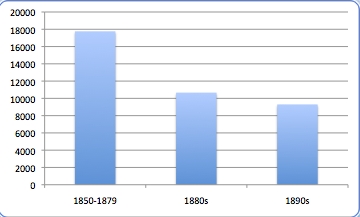To search the RPR site click here
Statistical methodology
Detailed and systematized documentation of the Pitt Rivers Museum's collections began in the 1920s and 30s when proper accession books were created for all new accessions (and, retrospectively, for all historical accessions) and card catalogue systems, which allowed all details to be easily retrieved, were established. In the 1980s this hard copy data began to be transferred onto computer and by the mid 1990s the Museum had complete, and complex, computerised collections management databases for all its objects used both internally by museum staff and externally, via the online versions, by members of the public and scholars from around the world.
The system works by identifying and codifying certain sorts of key facts that link all objects. All UK museums use similar systems to codify and catalogue their collections, loosely based upon Dublin Core metadata standards and museum documentation standards set by the Collections Trust.
Broadly the key items which have been interrogated to form this statistical analysis are:
Where is the object from? (Continent, class and region)
What is it? (Keyword (name), Class, material from which it is made, process by which it is made)
Who is associated with it, what are the dates associated with its making, collection, ownership and donation
In addition, information is provided regarding whether items can be defined as ethnographic, archaeological or other. For the second collection, we can also compare statistics about where the object was placed (Rushmore, Farnham).
We have used the broad database set-up used at the Pitt Rivers Museum to prepare a database of all the entries in the catalogue of the second collection, which is held by the Cambridge University Library. For the first time this allowed Pitt-Rivers' two collections to be considered together, compared and contrasted as all datasets are consistent. The statistical analysis therefore, so far as it is possible, considers the Pitt Rivers Museum's founding collection and the second collection in the same detail.
The statistical analysis that has been carried out has been simple and straightforward. Even so there are several points that need to be borne in mind. Firstly the statistics are only a 'snapshot in time', specifically in this case the data as it was in May 2010. As the project progressed after this date some of the data used in this analysis was found to be flawed but the statistical analysis, which is time-consuming, has not been repeated. This is because it is considered that the changes and reinterpretations are not significant statistically. In addition, there are some inherent biases in the data. Some founding collection entries are guesstimates, and this might marginally affect some figures (in isolated instances the exact number of objects is not known); in other cases it is impossible to avoid the effects of double counting as in (for example) the examination of countries, where more than one country might have been identified as possible provenances for a single object.
Charles Lutwidge Dodgson [Lewis Carroll] once wrote:
... long and painful experience has taught me one great principle in managing business for other people, viz. if you want to inspire confidence, give plenty of statistics. It does not matter that they should be accurate, or even intelligible, so long as there is enough of them. ... only circulate some abstruse tables of figures, particularly if printed in lines and columns, so that the ordinary readers can make nothing of them, and all is changed at once. 'Oh go on, go on!' they cry, satiated with facts. 'Manage things as you like! We trust you entirely!' [Dodgson, 'Three years in a Curatorship by one whom it has tried' 1886: quoted in Brock and Curthoys, 2000: 235]
Dodgson's cynicism as to the use of statistics, even those as accurate and thorough-going as presented on this website, is a useful exemplar for all readers of statistics. All of us can be blinded by the neat presentation of figures in 'lines and columns', into thinking we see a previously hidden truth, whilst in fact merely / mostly seeing the presentation of one version of the 'facts'.
AP, May 2010, revised December 2010; Lewis Carroll's wise words added November 2012
More information:
http://england.prm.ox.ac.uk/englishness-Lies-and-statistics.html
Blackwood, Beatrice 1970. The Classification of Artefacts in the Pitt Rivers Museum, Oxford (Occasional Papers on Technology, 11), Oxford: Pitt Rivers Museum, University of Oxford.
Coote, Jeremy, Chantal Knowles, Nicolette Meister, and Alison Petch 2000. ‘Computerizing the Forster (“Cook”), Arawe, and Founding Collections at the Pitt Rivers Museum’, Pacific Arts, nos 19/20 (July), pp. 48–80.
Petch, Alison 1999. ‘Cataloguing the Pitt Rivers Museum Founding Collection’, Journal of Museum Ethnography, no. 11 (May), pp. 95–104.
Petch, Alison 2002. ‘Today a Computerized Catalogue: Tomorrow the World’ Journal of Museum Ethnography, no. 14 (March), pp. 94–9.
Petch, Alison 2003. ‘Documentation in the Pitt Rivers Museum: The Contribution of Sir Francis Knowles (1886–1953)’, Journal of Museum Ethnography, no. 15 (March), pp. 109–14.
Petch, Alison 2004. ‘Collecting Immortality: The Field Collectors who Contributed to the Pitt Rivers Museum, Oxford’, Journal of Museum Ethnography, no. 16 (March), pp. 127–39.
Below is the PDF for an article written by Petch on 'Counting and Calculating: Some reflections on using statistics to examine the shape and history at the Pitt Rivers Museum' first published in the Journal of Museum Ethnography, no 18 (May 2006) pp. 149-156. We are very grateful to the Chair of MEG and the Editor of JME for permission to publish this pdf on our website.




